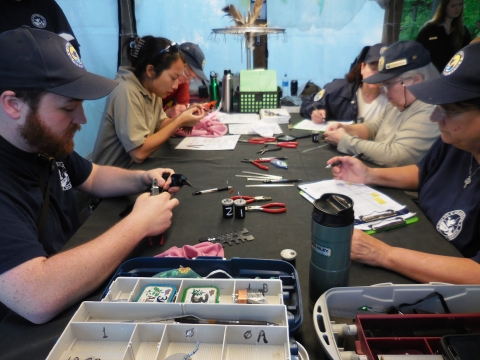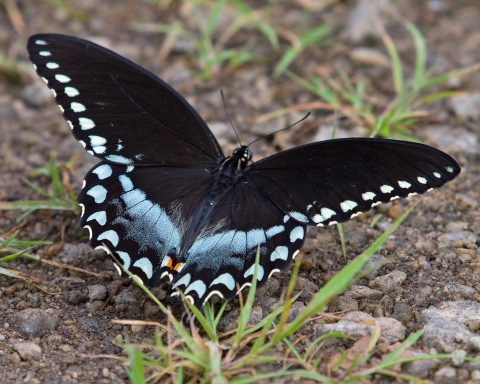Projects and Research
Integrated Waterbird Management and Monitoring Surveys
The Potomac River National Wildlife Refuge Complex participates in the Integrated Waterbird Management and Monitoring program, which provides valuable scientific data to wildlife managers across the country. Surveys for this program are conducted at Occoquan Bay National Wildlife Refuge and Elizabeth Hartwell Mason Neck National Wildlife Refuge to document the number of individuals per species that are using the wetlands during the non-breeding season. The complex also collects habitat data from the Integrated Waterbird Management and Monitoring sites, such as the type of vegetation and quality of seeds present, which can be used to determine the density of energy sources within the wetlands. This can provide a measure for how effective the habitat will be for supplying food and cover for waterbirds during the winter.
Bird Banding
Each spring, volunteers and U.S. Fish and Wildlife Service staff convene at the "bird banding station" on Occoquan Bay National Wildlife Refuge to fasten unique identification bands around the ankles of passerine birds. The group erects a large net made of very light material, known as a mist net, to capture the birds. When a bird flies into the net, a group member carefully extracts the bird, and data collection can begin. The band identification number and measurements for each bird goes to the United States Geological Survey North American Bird Banding Program, and helps them study the movement and behavior of birds.
For the 2023 season, the bird banding station will be open from March 19 to May 28 every Wednesday, Friday, and Sunday from 7AM to 12PM (weather permitting). Come out and see avian research in action with the help of our trained volunteers! Check out the map below to see where the banding station is located.
Towards the end of each winter, the Virginia Department of Wildlife Resources bands American Black Ducks on the refuge. Though American Black Ducks are the target species of their winter waterfowl banding project, all other waterfowl that are caught via swim-in traps or rocket nets are also banded. The purpose of this endeavor is provide estimates of year-to-year survival, which is based on the recovery and reporting of band numbers by hunters and biologists. This data is necessary when setting annual waterfowl hunting seasons.
Wildlife and Butterfly Surveys
A few times per month, a group of volunteers, led by co-volunteer and long-time refuge advocate Jim Waggener, traverses the trails of Occoquan Bay National Wildlife Refuge to document all wildlife and flowering plant species present. The survey has been conducted for over 30 years, and is part of a long-term citizen science effort, in association with the Audubon Society of Northern Virginia, to document the status of local birds and other wildlife in exemplary natural habitats. Data gathered from the site surveys are made available to respective resource managers and to the general public. Jim Waggener has a special use permit that allows him to conduct this project on the refuge.
Bat Acoustic Monitoring
In recent years, the Potomac River National Wildlife Refuge Complex has carried out resident bat inventories on its refuges. The biologist for the complex uses acoustic monitoring equipment to determine the species present on the refuges during the survey period.
Invasive Plant Mapping
The U.S. Fish and Wildlife Service staff keeps track of invasive plant species on the refuge using ArcGIS mapping, and determines the management actions necessary to curb their spread.







